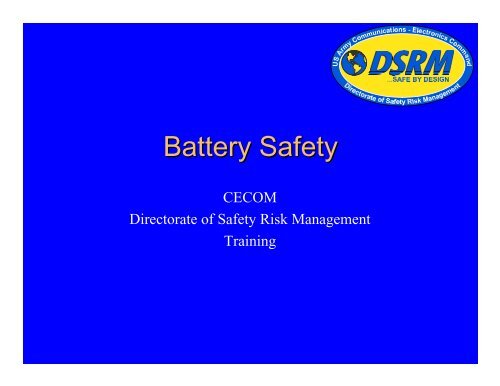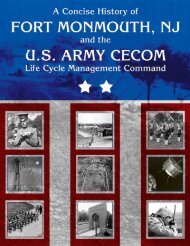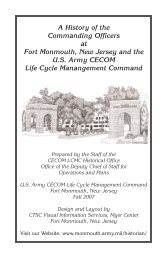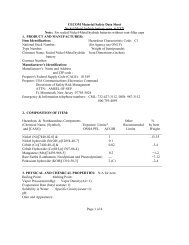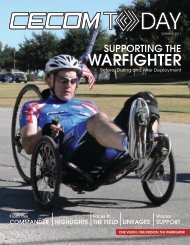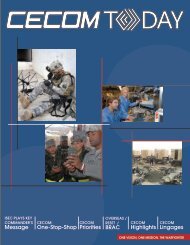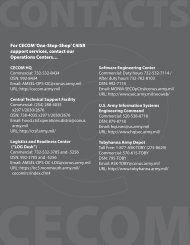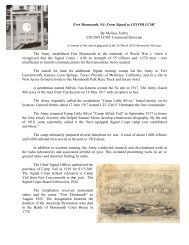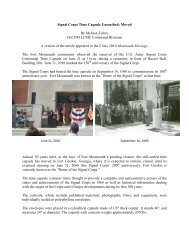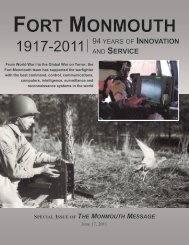Battery Safety - CECOM
Battery Safety - CECOM
Battery Safety - CECOM
- No tags were found...
You also want an ePaper? Increase the reach of your titles
YUMPU automatically turns print PDFs into web optimized ePapers that Google loves.
<strong>Battery</strong> <strong>Safety</strong><strong>CECOM</strong>Directorate of <strong>Safety</strong> Risk ManagementTraining
<strong>Battery</strong> <strong>Safety</strong> Topics● Intro● Primary <strong>Battery</strong> Issues● Secondary <strong>Battery</strong> Issues● What’s New!
Introduction● Purpose of this training:– Provide recommendations on safe batteryusage based on lessons learned– Inform you of what to expect in the areaof <strong>CECOM</strong> batteries of the future
Primary <strong>Battery</strong> Issues
AN/PRC-104BBA-5590/U Venting● Two BA-5590/U batteries with two different date codes installed● The older battery violently vented when the radio begantransmitting, destroying the battery compartment● GPM 97-007 issued - end items using two or more BA-5590’smust have batteries replaced in matched sets● Recommendations (for all equipment using two or more primarypower batteries):– Label equipment battery boxes with replacement requirements– Address requirements in TM and trainingStandard practice is the replacement of all prime powerbatteries at the same time
Multiple <strong>Battery</strong> Usage● When more than one prime power battery is used, alwaysreplace in sets of new/unused batteries with the same voltageand same chemistry● When using more than one LiSO 2 battery, they must bereplaced in matched sets of new/unused batteries● Matched batteries are from the same manufacturer, and havethe same contract number and date code● Bottom Line:– Never mix chemistry types– Never mix batteries with different voltages– Never mix primary and secondary batteries in the same equipment– Never mix discharged and fully charged secondary batteries– Never interchange battery types unless permitted by TM or approved by<strong>CECOM</strong>
AN/PSN-11BA-5800 <strong>Battery</strong>Explosions● Explosive incidents in the AN/PSN-11, GPS PLGR whenconnected to external power● Batteries charged in the PLGR when externally powered● GPM 96-012 issued:– Remove BA-5800/U when connected to external power● Labels provided for the PLGR and TM’s updated● Secure and protect loose batteries when removed● Recommendations: For new equipment ensure that you don’trely solely on the battery diode to prevent charging
AN/PSN-11Memory <strong>Battery</strong> Explosion● A lithium thionyl chloride memory battery exploded when theAN/PSN-11, PLGR was improperly installed in a HMMWV● The PLGR was improperly connected to the ungroundednegative vehicle battery terminal● When the PLGR battery cover contacted the metal vehiclechassis, the battery shorted, causing charging and explosion● GPM 97-005 issued providing proper PLGR installationprocedures● Wiring hookup schematics are available on our web page● Recommendations: Ensure TM’s adequately addressinstallation procedures and possible problems
PLGR Power ConnectionOPTIONA24VDC APPLIEDBAC(+) (-) (+) (-)12VDC 12VDC VEHICLEGROUNDOKOPTIONB12VDCAPPLIED(+) (-) (+) (-)12VDC 12VDC VEHICLEGROUNDOK12VDCAPPLIEDOPTIONC(+) (-) (+) (-)BAD!12VDC 12VDC VEHICLEGROUND
AN/PSN-11Memory <strong>Battery</strong> Leakage● The PCI Eternacell TO6/51 lithium thionyl chloride memorybattery (DLA) has a history of leakage in the PLGR● Leakage occurs at end of battery life in which a residualamount of thionyl chloride remains and corrodes the cell case● The batteries may become depleted when the PLGR is used orin storage● Leaking thionyl chloride may damage the PLGR/cause injury● GPM 97-004 issued requiring PCI batteries to be replaced withnew batteries● Batteries with date codes of 0997A and later are reformulatedand do not require replacement IAW GPM 97-004● Recommendations: Always remove batteries from equipmentprior to long term storage - Address in TM’s
DTD/ANCD(CYZ-10) Incident● The equipment uses three BA-5123/U or one 9v battery. Theseare the only authorized batteries for use in the CYZ-10● BA-5372/U batteries were incorrectly installed in the equipmentresulting in excessive heating and equipment damage● The BA-5372/U fits in the equipment, BUT, it has the wrongpolarity and higher voltage!● Recommendations: Ensure labels affixed to batterycompartments identifying proper batteries and address in TM’s
SAFT BA-5590Batteries● GPM 96-013 issued to minimize ventings of SAFT BA-5590’s:● Ventings of batteries continued to occur after issuance of GPM● SOUM 97-017 issued dead-lining SAFT BA-5590 batteries.– Contract numbers DAAB07-88-C-C045 and DAAB07-90-C-C020– Unexpired batteries being replaced by <strong>CECOM</strong>.– No credit for expired batteries.● Poor <strong>Battery</strong> Management!– Users not rotating stock– Stuck with expired batteries● Recommendations: Inform users of your battery poweredequipment to practice FIFO and not use expired batteries
Ballard BA-5800Batteries● AN/PSN-11, PLGR, is the primary user of BA-5800/U batteries● GPM 96-012 and 97-013 provides precautions, restrictions, anddisposal requirements of Ballard BA-5800/U batteries● Violent ventings during usage and disposal processing resultingin injury continue to occur● SOUM 98-001 dead-lines all Ballard BA-5800/U batteriesunder contract DAAB07-90-C-C024– Do not activate CDD of any of these batteries– Hold batteries as hazardous material until <strong>CECOM</strong> funding is available or dispose of ashazardous waste through local DRMO– <strong>CECOM</strong> to replace unexpired batteries only● SOUM also provides precautions for all other BA-5800’s● Recommendations: Inform users of your battery poweredequipment to return batteries for proper disposal processing
Ballard BA-5600Batteries● Two violent ventings occurred during usage and testing ofBallard BA-5600/U batteries causing equipment damage● GPM 98-002 provides restrictions with the continued use ofthese batteries:– Never use any of the subject batteries past their expiration date– Shut off all equipment when not in use.– Remove batteries from equipment if it is to be stored for longer than 30 days.– Secure and protect any loose batteries.● Important disposal restrictions apply:– Do not activate CDD of any of these batteries– Hold batteries as hazardous material until <strong>CECOM</strong> funding is available or dispose of ashazardous waste through local DRMO● Recommendations: Inform users of your battery poweredequipment to return batteries for proper disposal processing
LiSO 2 <strong>Battery</strong> DisposalProcessing● USERS MUST NOT ACTIVATE THE CDD● After use turn in all LiSO 2 batteries for proper disposal● The following procedures are to be performed by the authorizeddisposal personnel only:– Slit or remove the CDD label– Gently depress CDD with small screw driver– Separate batteries on all sides by at least 2 inches– Place batteries in secure, well ventilated area for a minimum of 5 days. DO NOTHANDLE!– When cool to the touch measure battery voltage– If voltage less than 1 volt per cell - dispose of as non-hazardous material– If voltage is 1 volt per cell or greater - push CDD a second time, wait 5 more days, andremeasure voltage - or dispose of as hazardous material● Recommendations: Inform battery users of these procedures - Includein TM’s
Primary <strong>Battery</strong>Summary●●●●●●●Replace batteries in matched sets - TM and labelingDo not rely solely on battery diodes to prevent charging - H/WAdequate installation instructions - TMRemove batteries prior to long term storage - TMUse authorized batteries only - labeling and TMDo not use expired batteries - check shelf life extensions - WebUsers are not to activate CDD’s - turn in for processing - TM
Secondary <strong>Battery</strong> Issues
MSE Lead Acid<strong>Battery</strong> Incident● MSE shelters utilize two vented lead acid batteries● A battery compartment vent hose is used to exhaust hydrogenproduced during charging to the outside of the shelter● <strong>Battery</strong> vent hose left disconnected during maintenance● <strong>Battery</strong> boil over generated excessive hydrogen within theshelter and exploded by a spark from the electric heater● GPM 96-002 issued reiterating proper maintenanceprocedures● Recommendations. Address precautions in TM:– Never charge bad batteries– Never operate battery charger without ventilation– Sealed lead acid battery replacements available
BB-390A/U NiCd<strong>Battery</strong> Incident●●●●●The BB-390A/U NiCd battery was inadvertently installed in the MPS-5Uninterruptible Power SupplyThe MPS-5 is designed for use with the BB-490/U lead acid battery onlyThe BB-390A/U battery overheated and was damaged during chargingGPM 97-012 issued:– NEVER substitute the BB-490/U (lead acid) with the BB-390A/U (NiCd)– Replace the BB-490/U with BB-490/U or MRC-490 batteries only– The BB-390/U must be charged using the PP-8444/U, PP-8444A/U, or PP-7286/U(with appropriate settings)– <strong>CECOM</strong> will continue to substitute the BB-390A/U for the BB-590/U NiCd batterysince they are interchangeableRecommendations. Ensure equipment TM’s specifies all possible replacementbatteries
CHS-2 UPS SLAB Incidents● The CHS-2 UPS uses two Sealed Lead Acid Batteries in aremovable battery pack● Over-discharged batteries installed in the UPS experienced swelling● Charging swollen batteries:– results in excessive temperatures of the battery pack and UPS causing a fire orburn hazard– may cause battery rupture that sprays battery acid or ignites hydrogen– causes equipment damage● Swelling of batteries prevented by keeping batteries charged● Charge more often under high temperatures● GPM 98-003 issued providing inspection and test procedures● Recommendations. Ensure users of the CHS-2 UPS are performinginspection and test procedures IAW GPM
What’s New and What to LookOut For● State of Charge Indicators (SOCI) are being integrated in numerousLiSO 2 and rechargeable batteries– The SOCI provides % of remaining battery capacity in increments– Provides an accurate status of batteries prior to and during missions– Users will not need to carry or use an external state of charge meter– Integrated SOCI’s will reduce disposal of “good” batteries in which SOCmeters are not readily available● Modified rechargeable batteries to prevent charging of primarybatteries inadvertently installed in chargers● BA-5600/U and BA-5800/U rechargeable battery equivalents● BA-5347 batteries - LiMnO 2 versions of the BA-5847● A new type of CDD - utilizes a strip under the label to be pulled outfor activation


